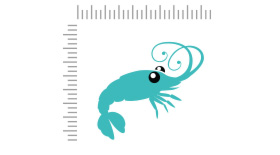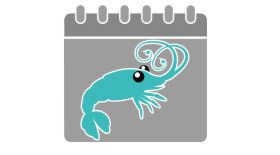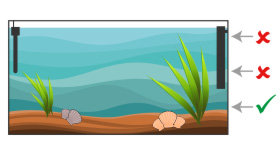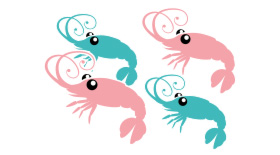

Alternative species (click on the thumbnail to see the card)
None (Yet!)
Names
Scientific name
Atyopsis moluccensis
Atya moluccensis
Atya armata
Atya bisulcata
Atya gustavi
Atya lineolata
Common name
Bamboo shrimp
Fan shrimp
Filter Shrimp
Asian Filter Shrimp
Wood Shrimp
Timber shrimp
Singapore Shrimp
Marble Shrimp
Mountain Shrimp
Rock Shrimp
Maluku shrimp
Flower shrimp
Origin

Origin: Southeast Asia (Sri Lanka, India, Malaysia, Thailand, Java, Sumatra, Borneo, Bali, Sulawesi, New Caledonia, Philippines, New Guinea, Fiji)
Biotope: not-specific
Dimorphism

The female is larger than the male
Group

Atyidae
Volume

120 L / 26 Imp Gal / 32 US Gal
Parameters

T°: 24 to 28°C or 75 to 82°F
pH: 7 to 7.5
Hardness: 10 to 15°dGH
Difficulty

Easy
Size

Male: 6cm-2.4" / Female: 12cm-4.7"
Longevity

2 to 4 years
Living zone

Depth
Individuals

5
Food
How to feed the Bamboo shrimp?
Food
How to feed the Bamboo shrimp?

Like all shrimp, the bamboo shrimp is a scavenger.
Thanks to a pair of specialized legs (fan-shaped), this shrimp feeds on micro-foods (infusoria, nauplia and others) suspended in the water. To do so, it faces the current and unfolds its pretty fans. If your aquarium is not "rich" enough in waste, you can distribute powdered shrimp food (there are specialized filter shrimp food), powdered spirulina or fry powder.
Finally, note that these shrimp can also pick up their food from the ground. This can be leftovers from fish meals, or decomposing dead leaves, for example.
Behavior
What kind of behavior does the Bamboo shrimp have?
Behavior
What kind of behavior does the Bamboo shrimp have?
Sociable, she likes to live in a group of about ten people.
She spends most of her time facing the current to catch her next meal in the water. It should be noted that she tends to be nocturnal and hides during the day.
This shrimp moults regularly (every 3-4 weeks) if it is maintained correctly. This stage allows it to grow and renew its carapace. Immediately after moulting, it takes some time before the new carapace hardens. The shrimp is then very vulnerable and it knows it! It spends a long time hidden to protect itself from predators. Note that it is after the moult that the females are fertile.
Cohabitation
Who can live with the Bamboo shrimp?
Cohabitation
Who can live with the Bamboo shrimp?
Despite its large size, it is perfectly harmless to fish and fry. Its cohabitation therefore poses no problem with the great majority of species (except for the predatory shrimp of course). However, it should be noted that some aggressive fish can come and tickle their fans, which would prevent shrimps from feeding peacefully. Typically, these are the Barbus type fishes or large cichlids.
Breeding
How to breed the Bamboo shrimp?
Breeding
How to breed the Bamboo shrimp?
The breeding of bamboo shrimp is very difficult and in captivity, they are almost non-existent, even in breeding farms. The difficulty lies in the growth of the larvae which must go through a very precise period in salt water. Reproduction is said to be amphidromous (indirect).
Each incubation lasts about 3 weeks and involves about a hundred eggs. The female keeps the eggs under her abdomen throughout this process.
Its aquarium
Which aquarium for the Bamboo shrimp?
Its aquarium
Which aquarium for the Bamboo shrimp?
The minimum volume required for the maid now of these large shrimp is 120 L / 26 Imp gal / 32 US gal for a small troop of 5-6 specimens. From this volume, count 25 L / 5 Imp gal / 7 US gal additional for each added shrimp.
A "classic" aquarium with roots, stones and plants will satisfy this invertebrate perfectly.
Like many invertebrates, the bamboo shrimp is sensitive to nitrates and phosphates (and a little bit to nitrites). Therefore, the water quality must be very good. Always install good filtration in its aquarium. In addition, a powerful filtration will generate a lot of current and offer an excellent oxygen level in the water, which corresponds perfectly to the natural living conditions of this species. Choose a powerful filtration, ranging from 10 or even 20 times the volume of the tank!
Good To know
Find all additional information!
Good To know
Find all additional information!
Its coloration depends in part (in addition to its geographical area of origin) on its diet and decoration. Thus, this shrimp can present colors ranging from brown to orange, through a very beautiful copper-green color.
It has a kind of broom that allows it to catch its food in the current of the aquarium.
Beware of the confusion between Atyopsis moluccensis and Atyopsis spinipes which are two distinct species (rostrum, spines, pleopods, geographical distribution ...), and not synonyms.
Yours photos!
Comments
Sort by:
Please login to post comments

